 Better to be really big and just do nothing wrong! The Asus RX480 Strix is not only an impressive visual appearance with three fans, but also a very successful compromise of reason and performance. There is a good reason why we are putting this forward, because compared to almost all other interpretations of the RX480, Asus has actually done everything right to really get justice for the Polaris chip.
Better to be really big and just do nothing wrong! The Asus RX480 Strix is not only an impressive visual appearance with three fans, but also a very successful compromise of reason and performance. There is a good reason why we are putting this forward, because compared to almost all other interpretations of the RX480, Asus has actually done everything right to really get justice for the Polaris chip.
With a factory clock of "only" 1310 MHz and a rather moderately set power limit, one does not want to get the power crown, which would perhaps make up one or two FPS more, but one concentrates on old strengths, when the DirectCU coolers still have a Quasi-Refrenz.
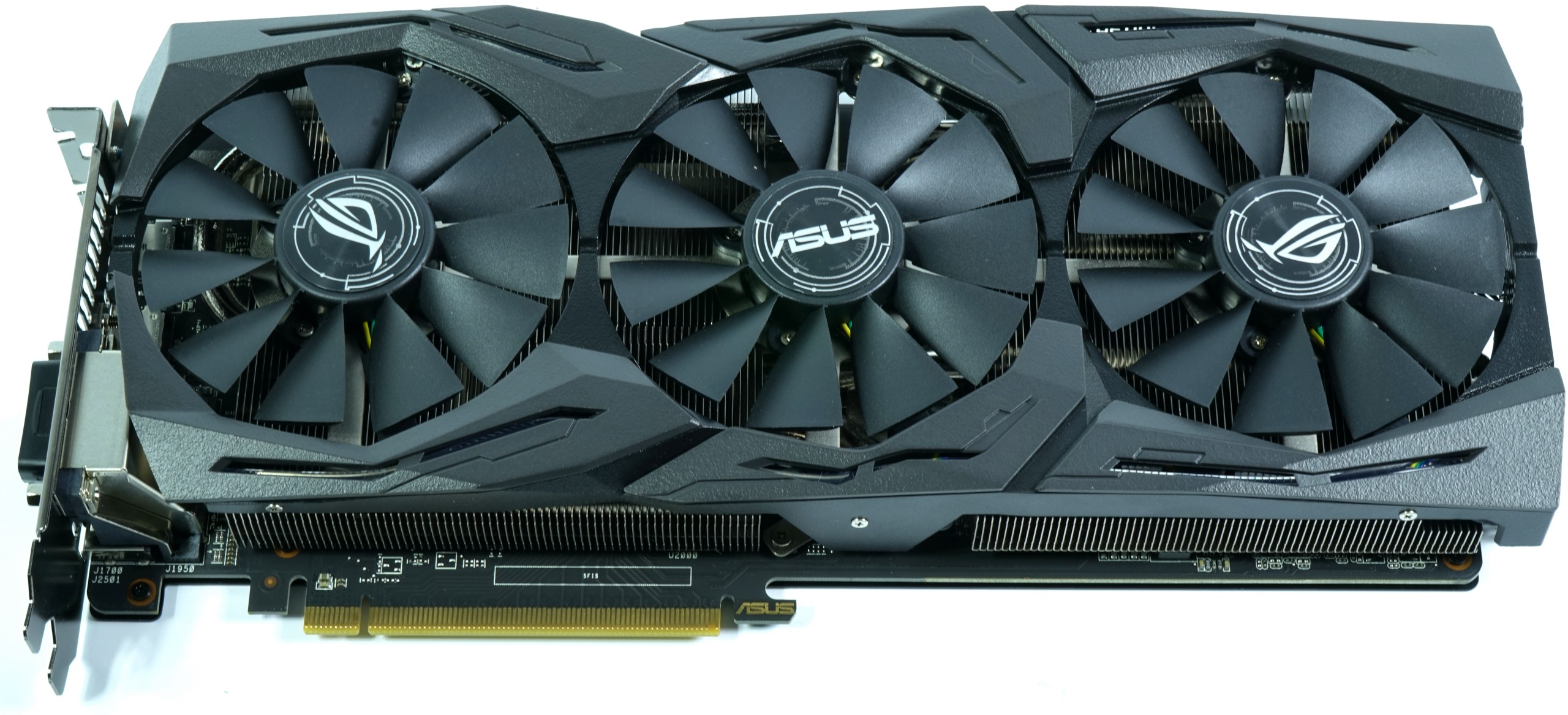
1. External appearance and key data
With 1041 grams, this card is a real heavyweight and with a real installation length of 30 cm (slot panel outside to rear edge radiator cover), a mounting height of 12.6 cm (upper edge slot to top edge radiator cover), and a mounting depth of 3.5 cm, it is also a true dual-slot card, which could also cause space problems due to the length in smaller enclosures.
The backplate requires an additional 0.5 cm of installation depth on the back, which has to be taken into account in ITX projects and CPU tower coolers. From a purely visual lynot, the map shows the usual Strix design, which is also continued with an LED-lit logo as part of the backplate. This is really eye-catching and a real eye-catcher for anyone who uses their PC with a side window.
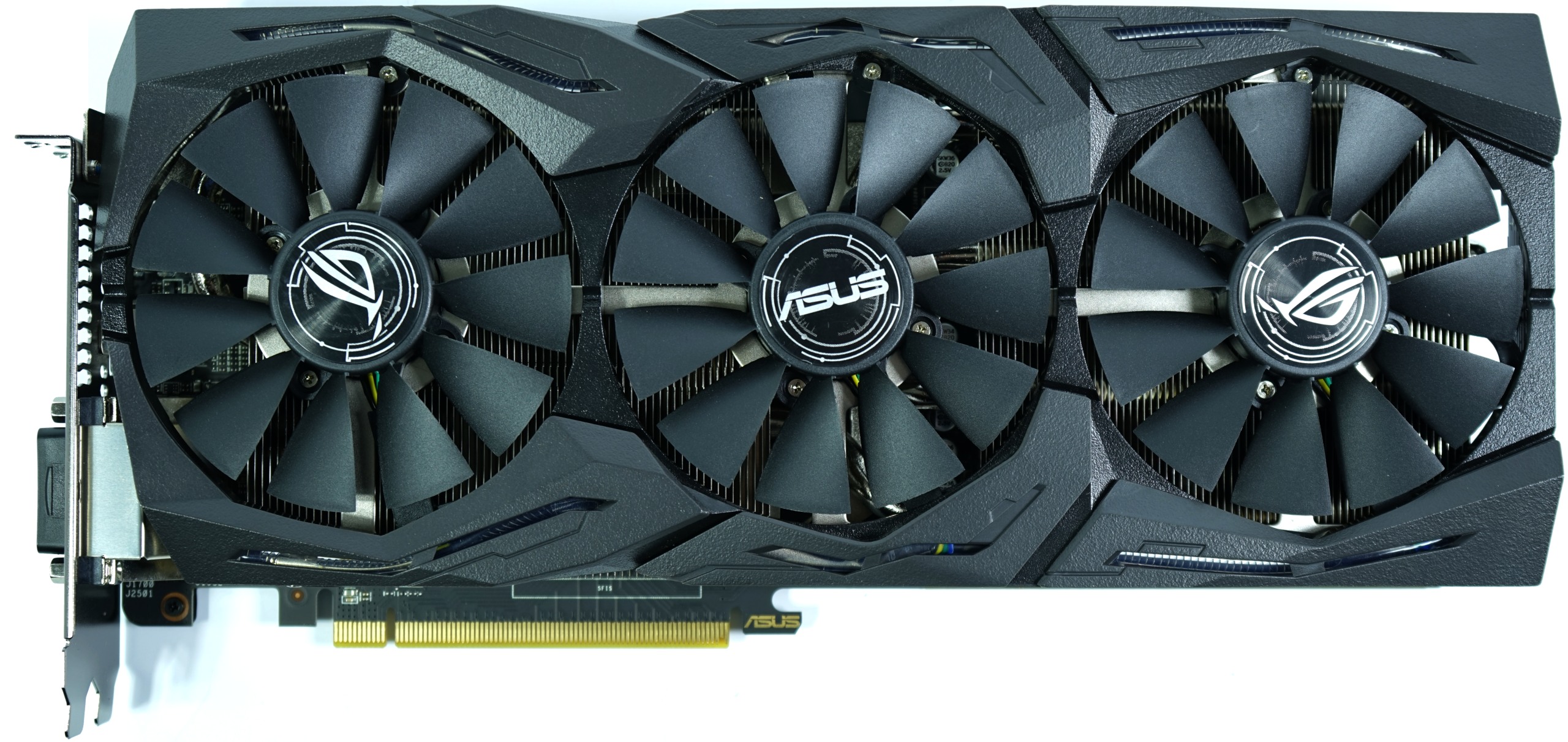 |
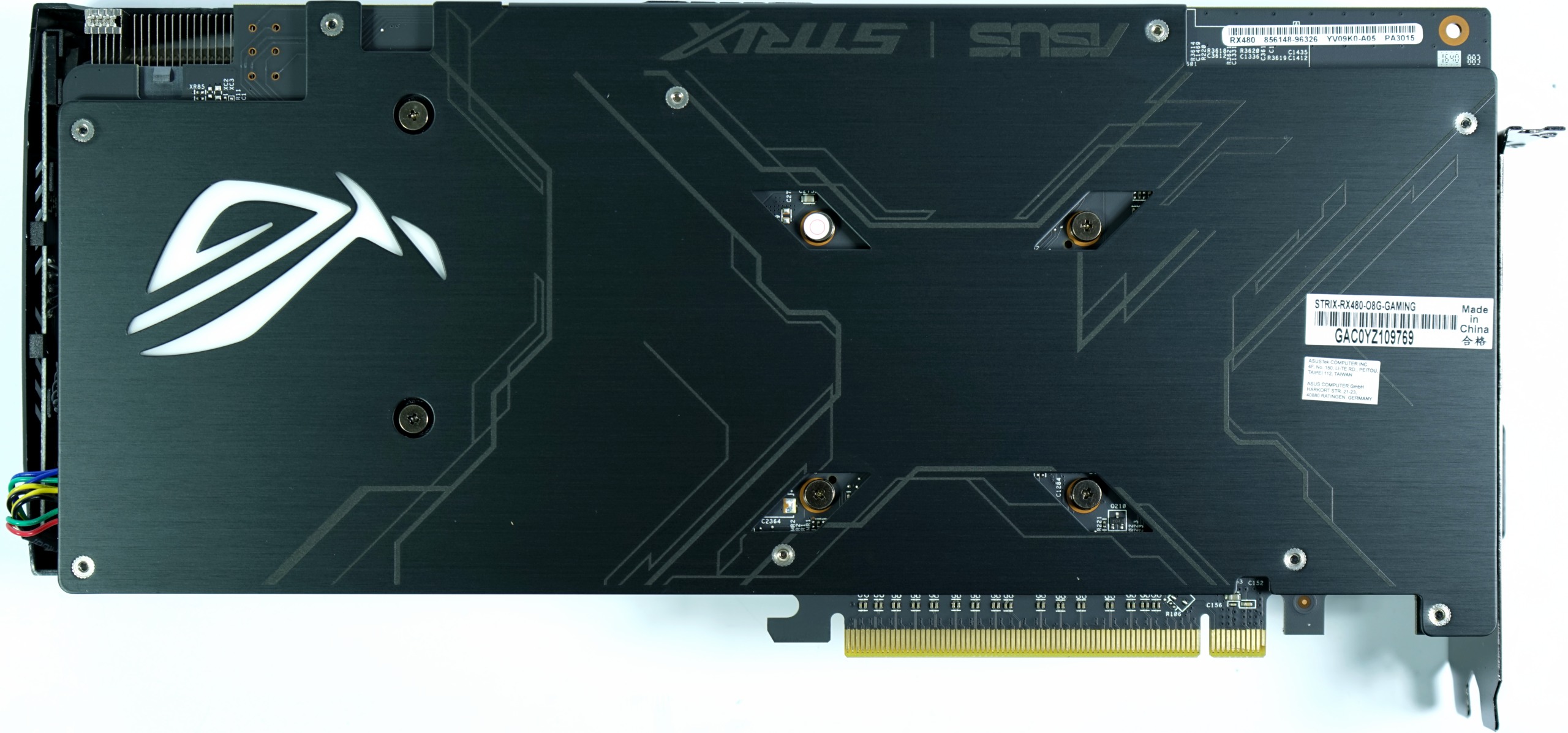 |
The plastic radiator cover is optically ok, but haptically not the howler. For this it is at least useful and it is sufficiently stable for the high card weight. The three 8.5 cm fans are real swirling arts, where even relatively low speeds still provide good throughput. Static pressure is less needed for these rather flat cooling solutions.
The slat orientation of the DirectCU III cooler is vertical, which also makes logical sense due to the three-fan design. The top shows the expected 8-pin PCIe power supply connector and is otherwise just as unobtrusive as the bottom of the card. If you want to see more of the cooler, you have to take it off, which we will do in a moment.
 |
 |
The end of the card presents two PWM-controlled fan shots, to which, for example, one could connect two housing fans that only really start to kick off when the card gets too hot. This is a good idea in itself, but very many enclosures in the front have usually only installed 3-pole, voltage-controlled fans ex works. And it's not exactly what it's all about, especially since Asus is unfortunately also silent about the possible maximum load.
The slot panel is well equipped with connectors and carries a DVI-D connector, as well as two ports for the DisplayPort 1.4 and two HDMI-2.0 outputs, which makes the connection of some VR glasses much easier. In between are air openings, which are supposed to release some of the waste heat outwards, but are actually completely useless due to the slat orientation.
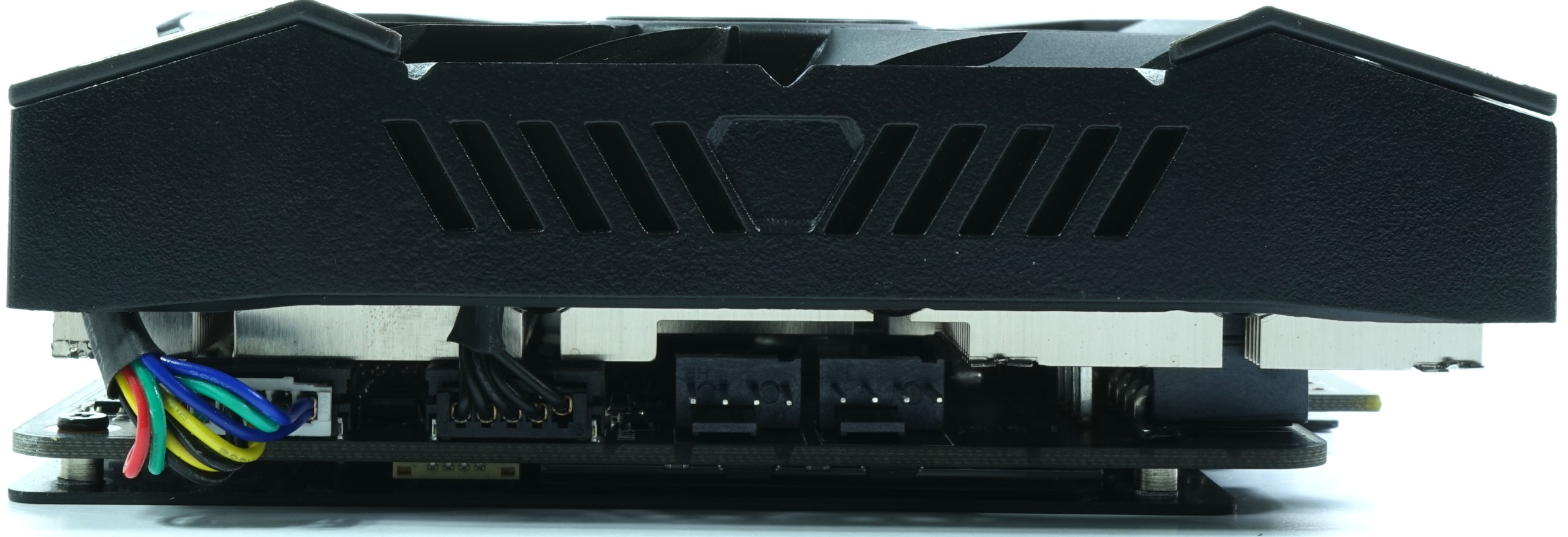 |
 |
2. Board layout and power supply
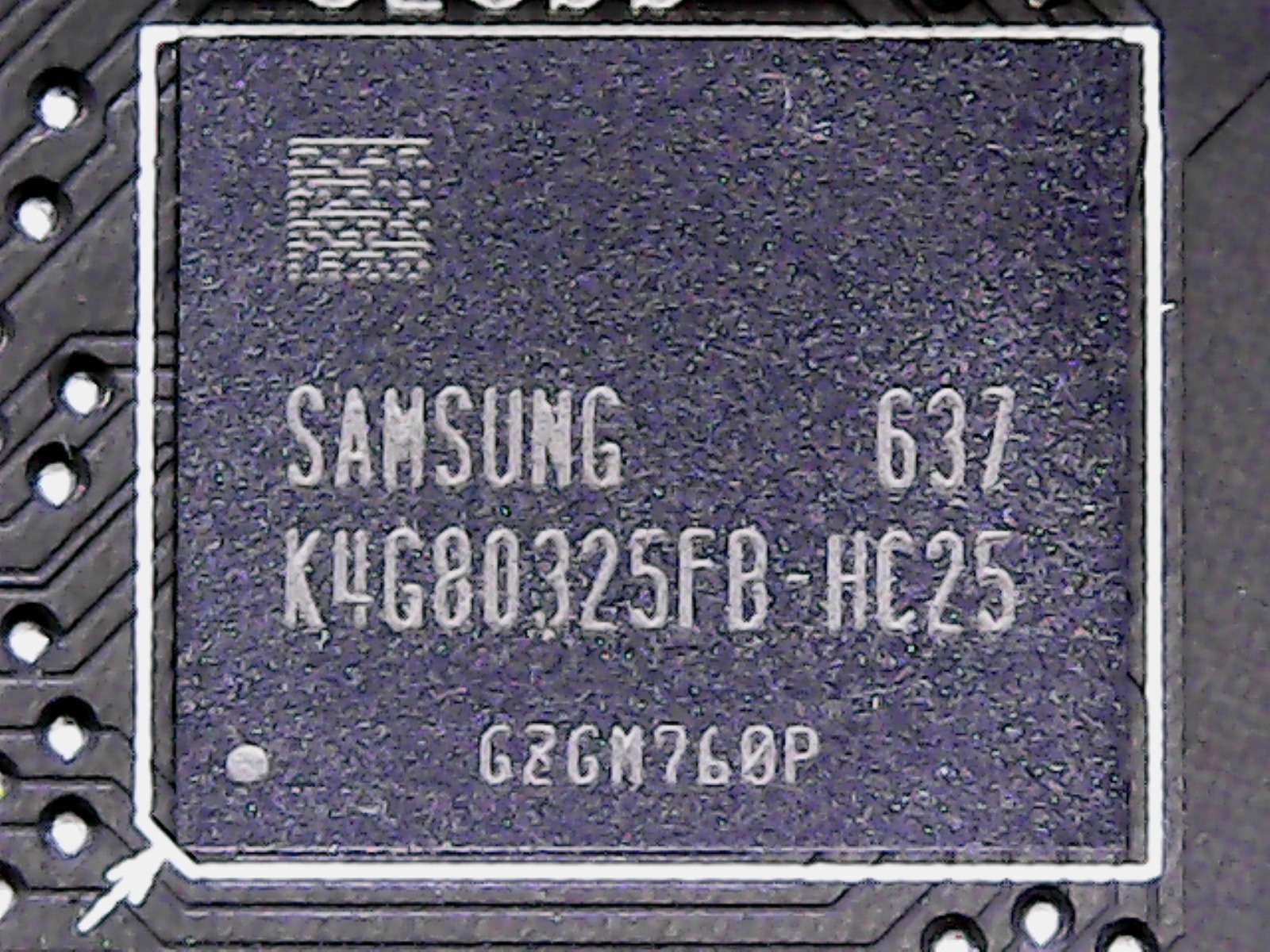 If we take the backplate, the stabilization frame, as well as the cooler, we can take a look at the board. Asus positions the GPU, memory, and accessories voltage converters all on the right to the end of the card, while a yawning void is found on the left side.
If we take the backplate, the stabilization frame, as well as the cooler, we can take a look at the board. Asus positions the GPU, memory, and accessories voltage converters all on the right to the end of the card, while a yawning void is found on the left side.
In terms of memory, Asus, like its reference and competitor, uses the K4G80325FB HC25 to a total of eight 1GB DDR5 modules from Samsung. This consumer memory is specified for operating temperatures of up to 85°C and is operated on this card with 2000 MHz.
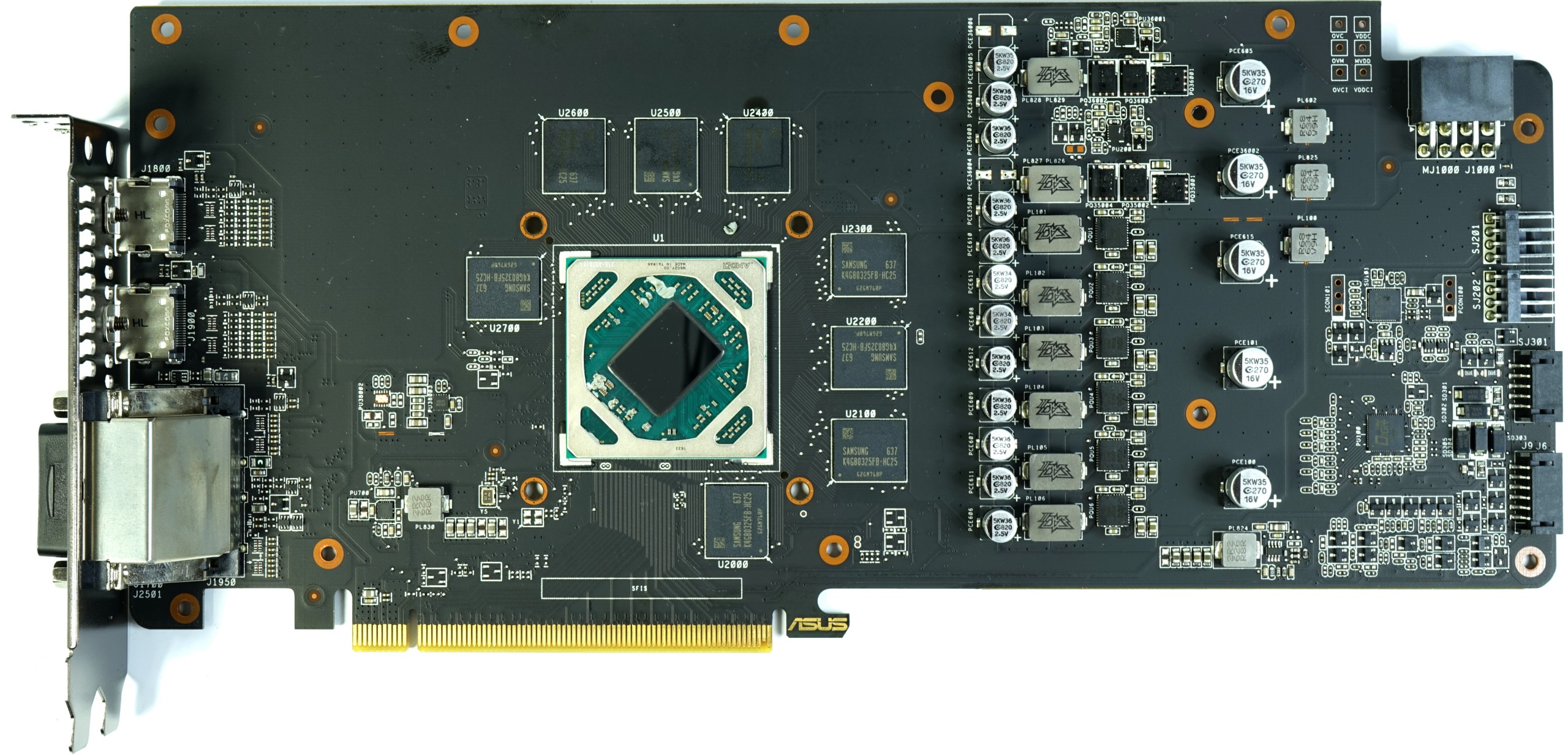 |
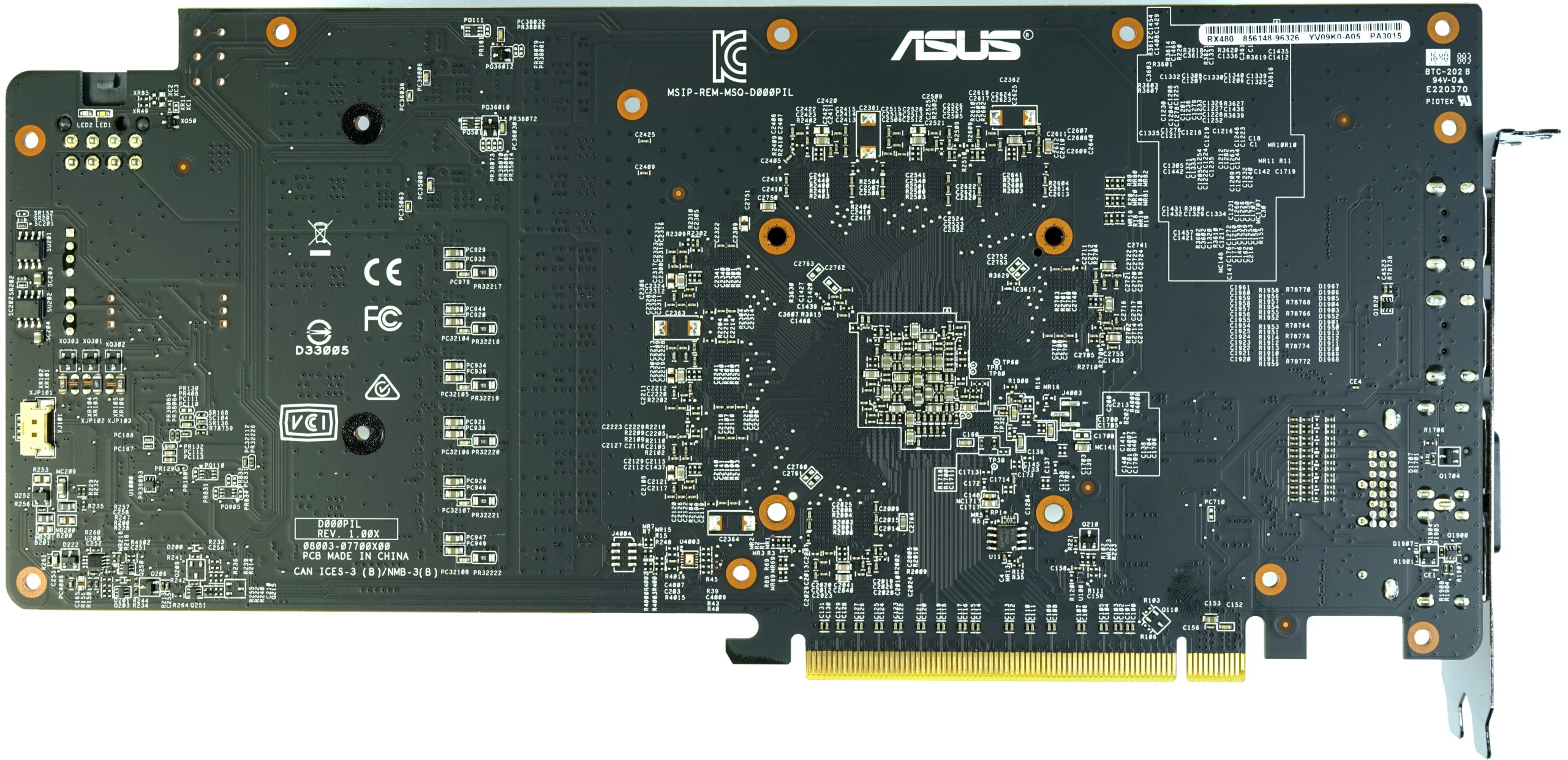 |
The GPU uses six individual phases provided by an ASP1300 from International Rectifier. The special feature of this special, very flexibly programmable PWM controller is that OC features can use a more extensive command set via the SMBus and could even use a VID of up to 2.3V. Things like a freely configurable maximum voltage, VID Override or Track, an individual load-line calibration (Digital Load Line Adjust) and an OVP/OTP complete the rather unusual chip.
The IR 3555 from International Rectifier is a highly integrated voltage converter chip that fits perfectly with the PWM controller and combines the necessary gate drivers as well as the MOSFETS for the high and low side, as well as the necessary Schottky diode in one package. The very efficient operation of the PWM controller ("Adaptive Transient Algorithm") also reduces the necessary capacitor sizes for later smoothing and also helps to reduce the resulting voltage transformer noise at the coils. However, they cannot be avoided altogether.
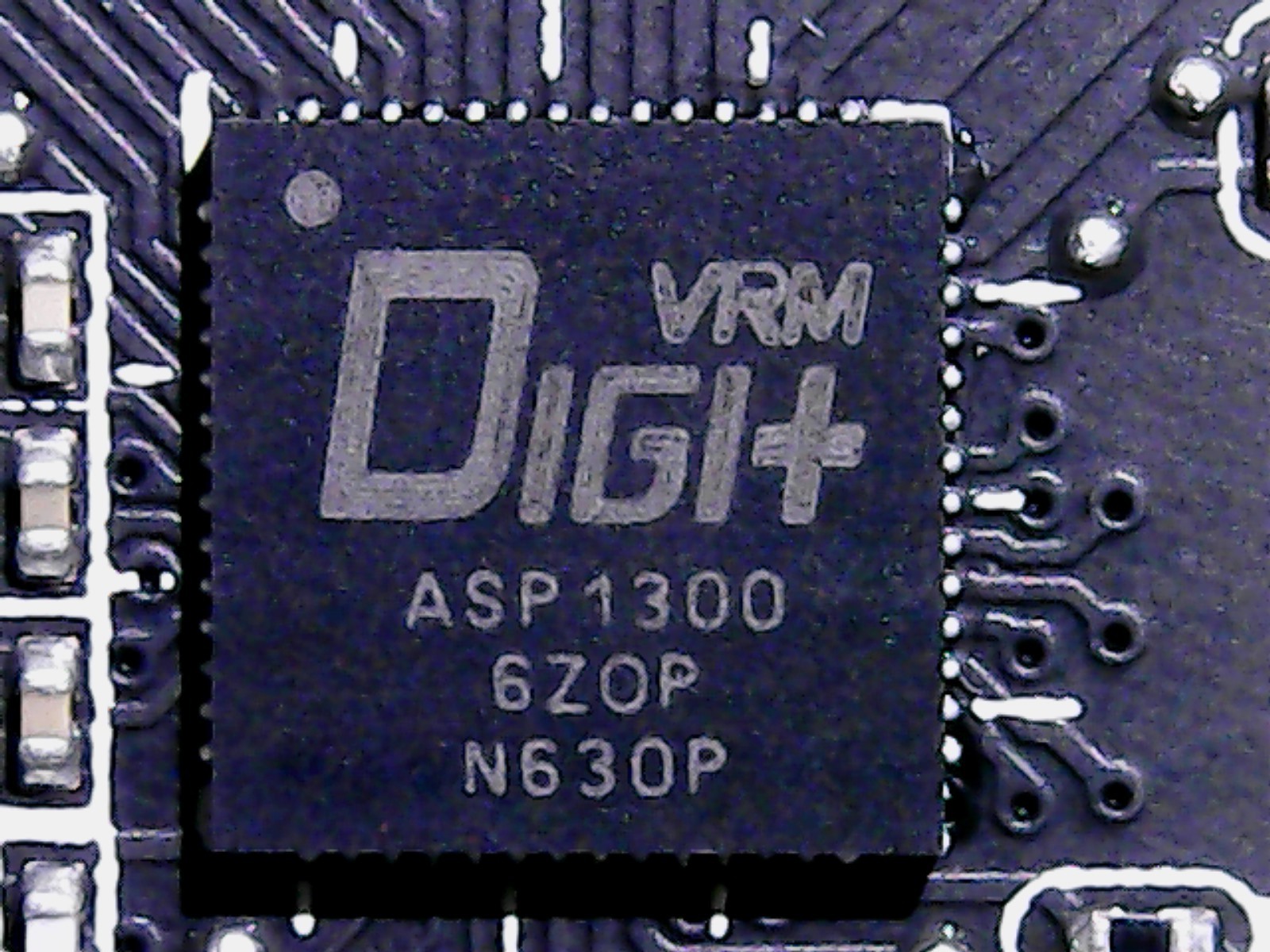 |
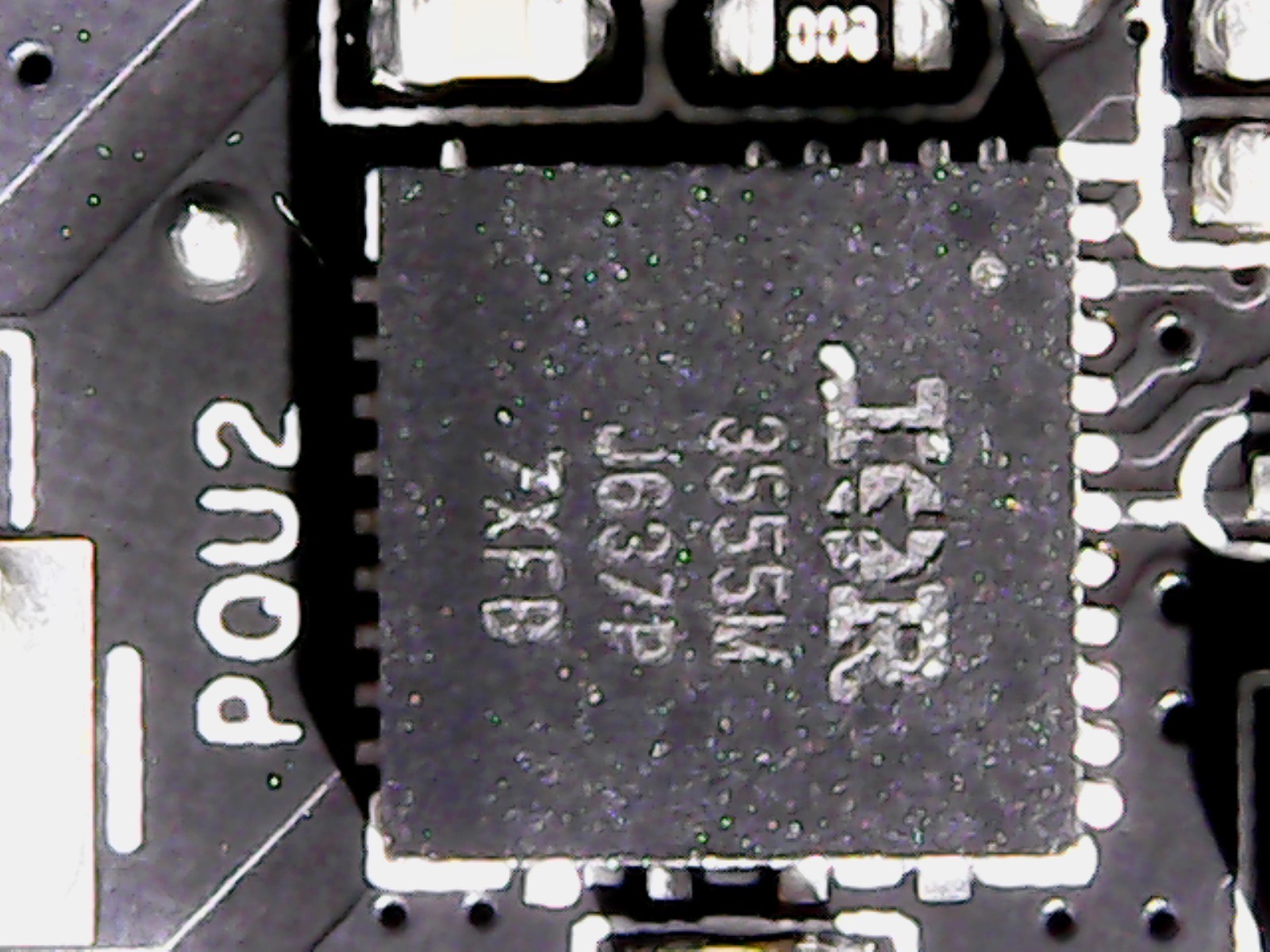 |
The coils used follow the in-house Super-Alloy-Power (SAP) feature, which is intended to guarantee a particularly stable power supply in full-bodied form. SAPII is the name of Asus, Military Class at MSI and in the end the coils, capacitors and other selected components are intended to guarantee a higher load capacity and service life. You can't check it, but at least it sounds great for now.
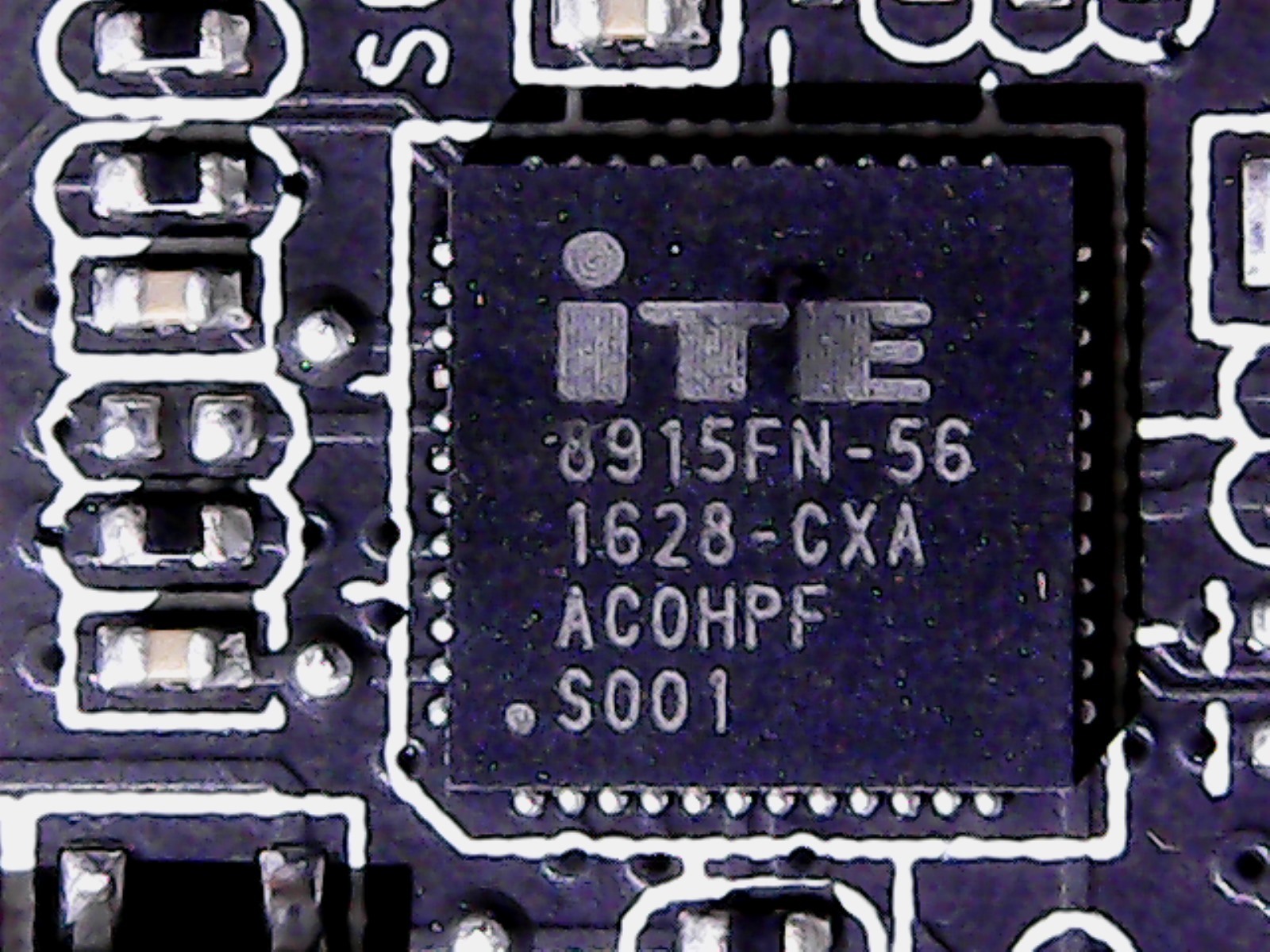 |
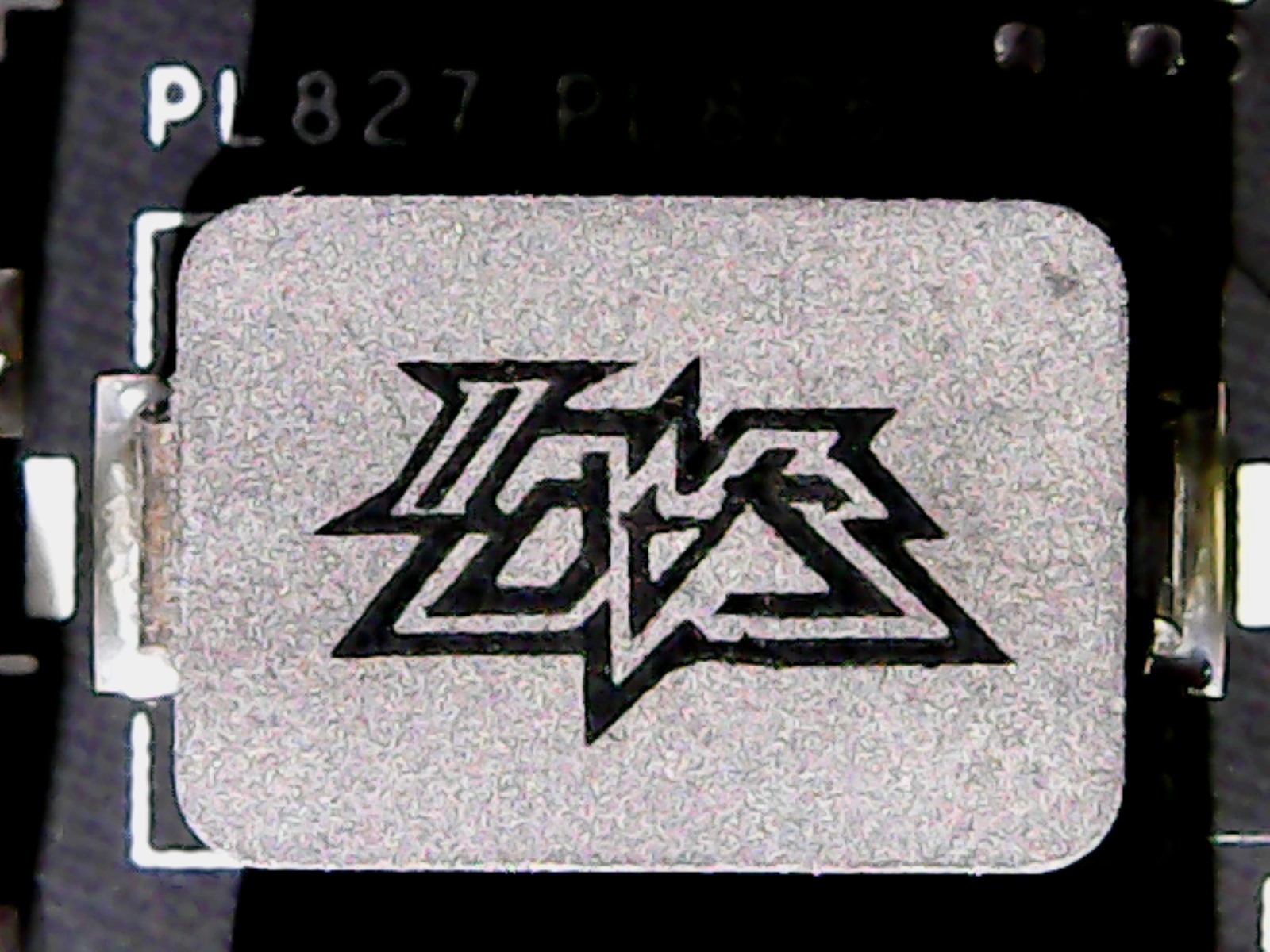 |
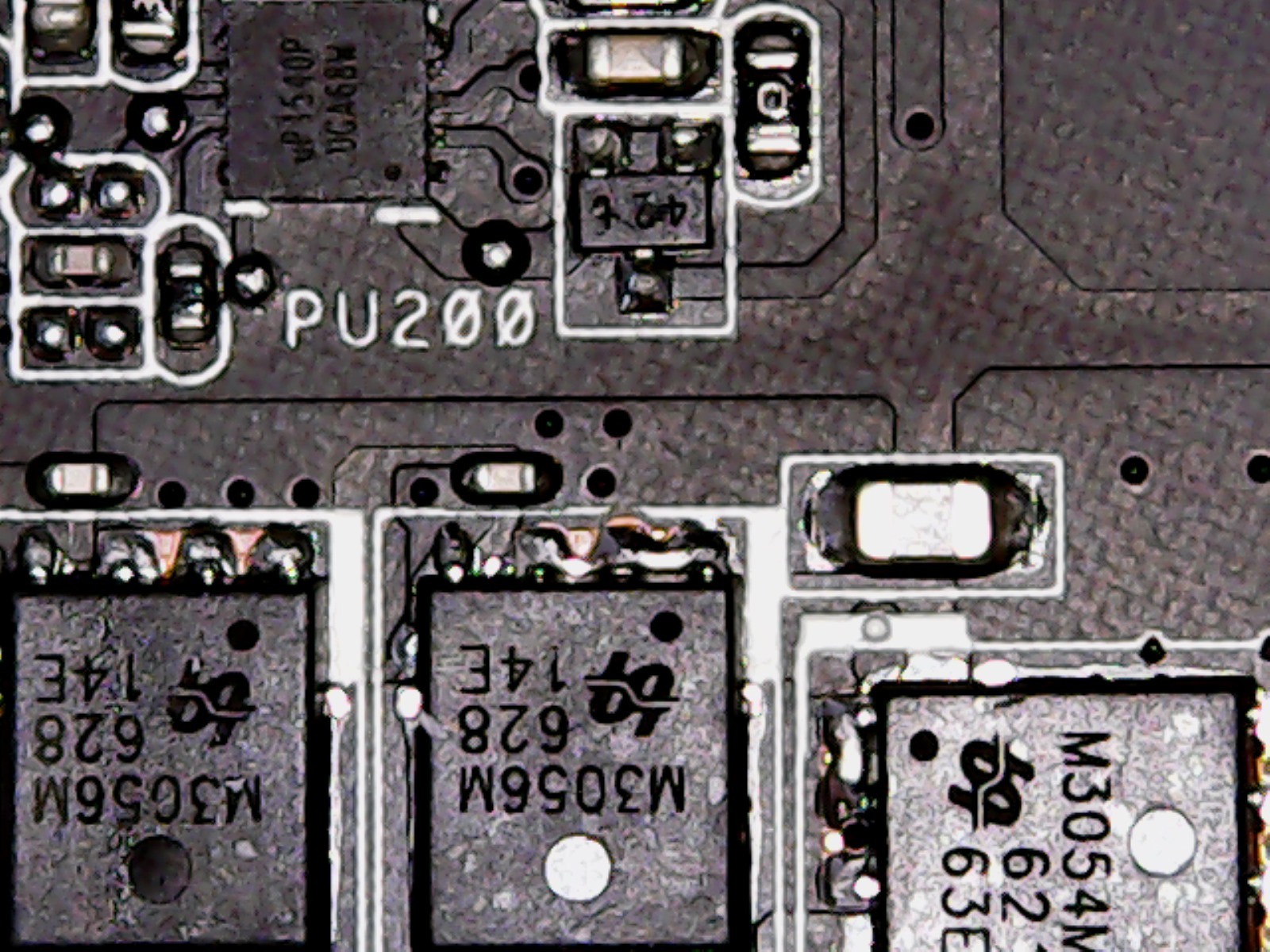
In the case of the voltage converters for the memory, one relies on a rather conservative solution, whereby one phase must suffice. A second voltage converter, which at first glance is similarly designed, then supplies the peripherals and controllers and has a slightly easier smoothing.
With the uP1540 as a PWM controller, an M3054 is controlled on the high-side for each of these two phases, which is just as much an average N-channel MOSFET as the two M3056, each of which is a pair parallel to the low-side Work.
3. Power consumption and compliance
The power consumption is not very much higher than what we were able to measure for the reference design, which has already been liked. The almost 20 watts in the idle are no longer up-to-date, however, but are due to the generously sized voltages and the high idle clock of at least 300 MHz. AmD will have to make improvements here for future generations.
In the gaming loop, the map reaches approx. 175 watts and is thus only moderately above the values of the reference card, while in the Torture loop only 173 watts are due, which result from the reasonably calculated power limit of 180 watts. Much more can then hardly be done, whereby the peak values represent only short moment values, which do not have to be used as a guideline for the power supply measurement, but show that one should already pay attention to a qualitatively appropriately equipped secondary side of the power supply . Low Impedance Caps).
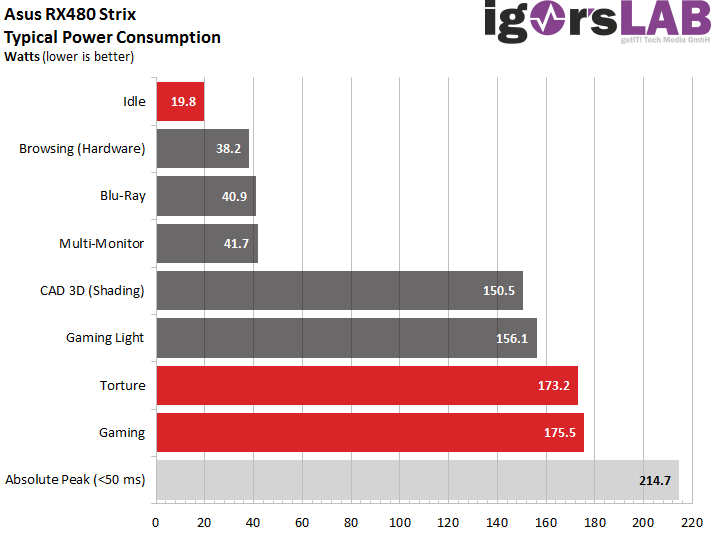
The two graphs that follow illustrate the course over 2 minutes each in the gaming loop and in the Torture test, on which the respective calculation of the average power consumption is based.
 |
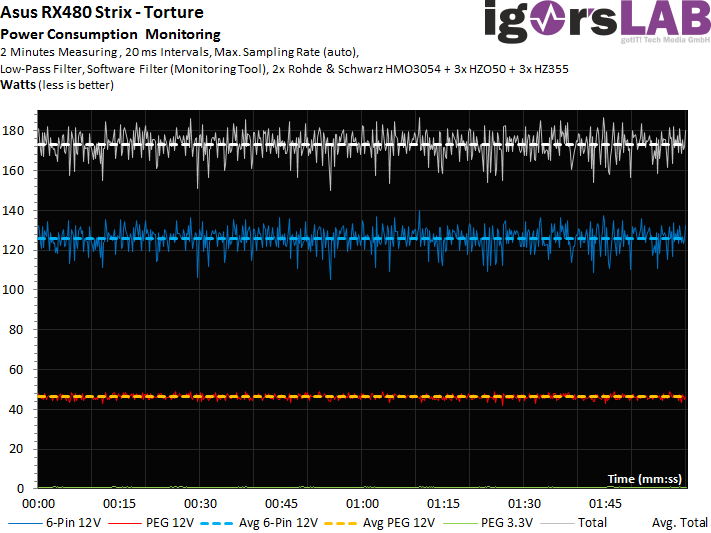 |
Now let's come to the evaluation of the flowing currents and they let the user sleep very quietly compared to some other maps. First, let's take a look at the current flows of the individual supply rails corresponding to the diagrams above:
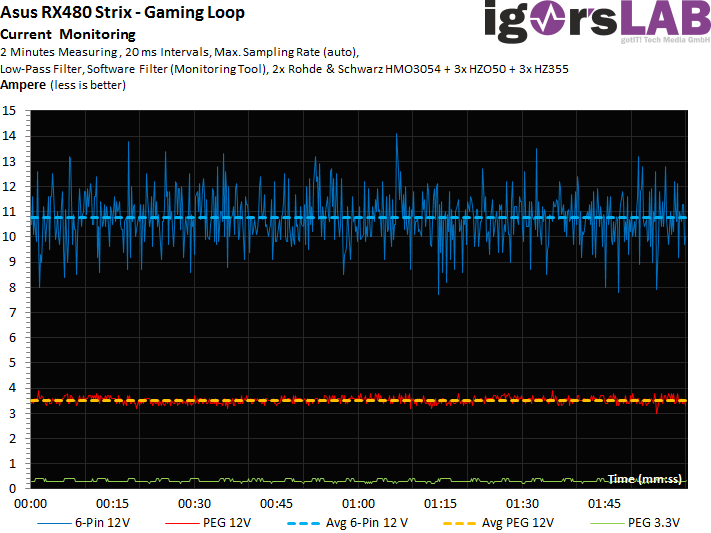 |
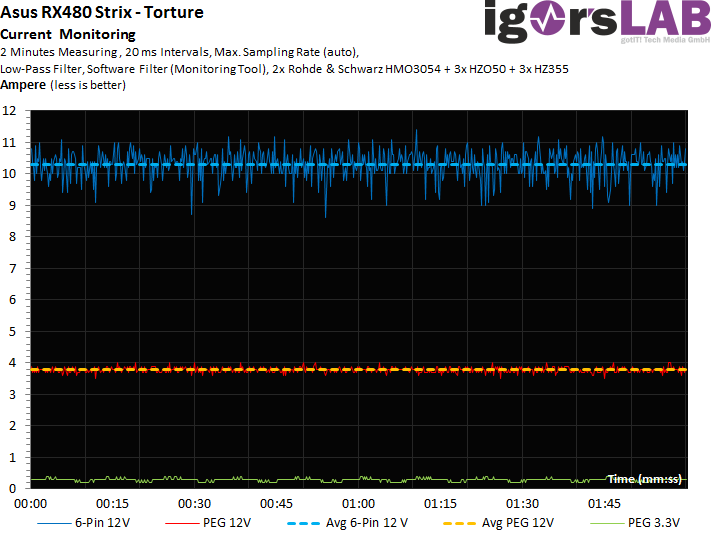 |
What we see can be reassuring. A total of 3.8 amperes instead of the maximum specified 5.5 ampers are really reassuring, even when used on older mainboards. Asus only powers the memory through the motherboard slot, while the six phases for the GPU are fully powered by the external 8-pin port.
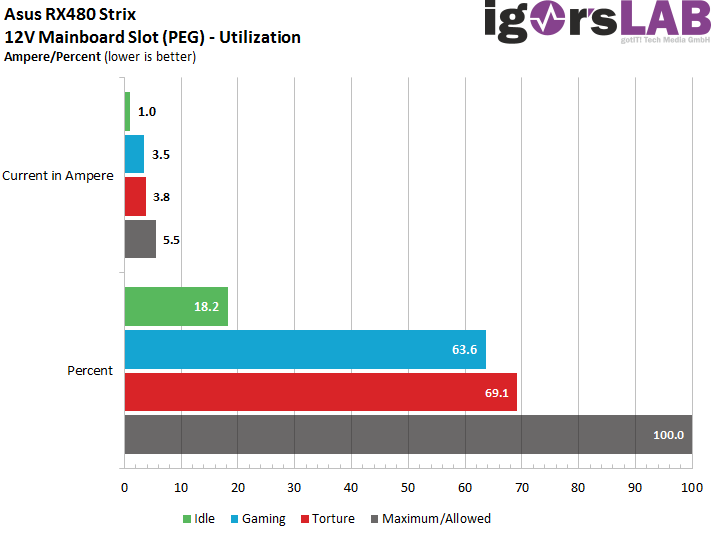
4th. Cooler structure and temperatures
The cooling concept relies on a conservative design consisting of the radiator, the board and the backplate, in which only an auxiliary frame is used to cool the storage. The backplate itself is not actively included in the cooling concept via thermal guide pads. However, we see very well the LED solution for the illuminated logo including the white spreadfilm on the back of the backplate.
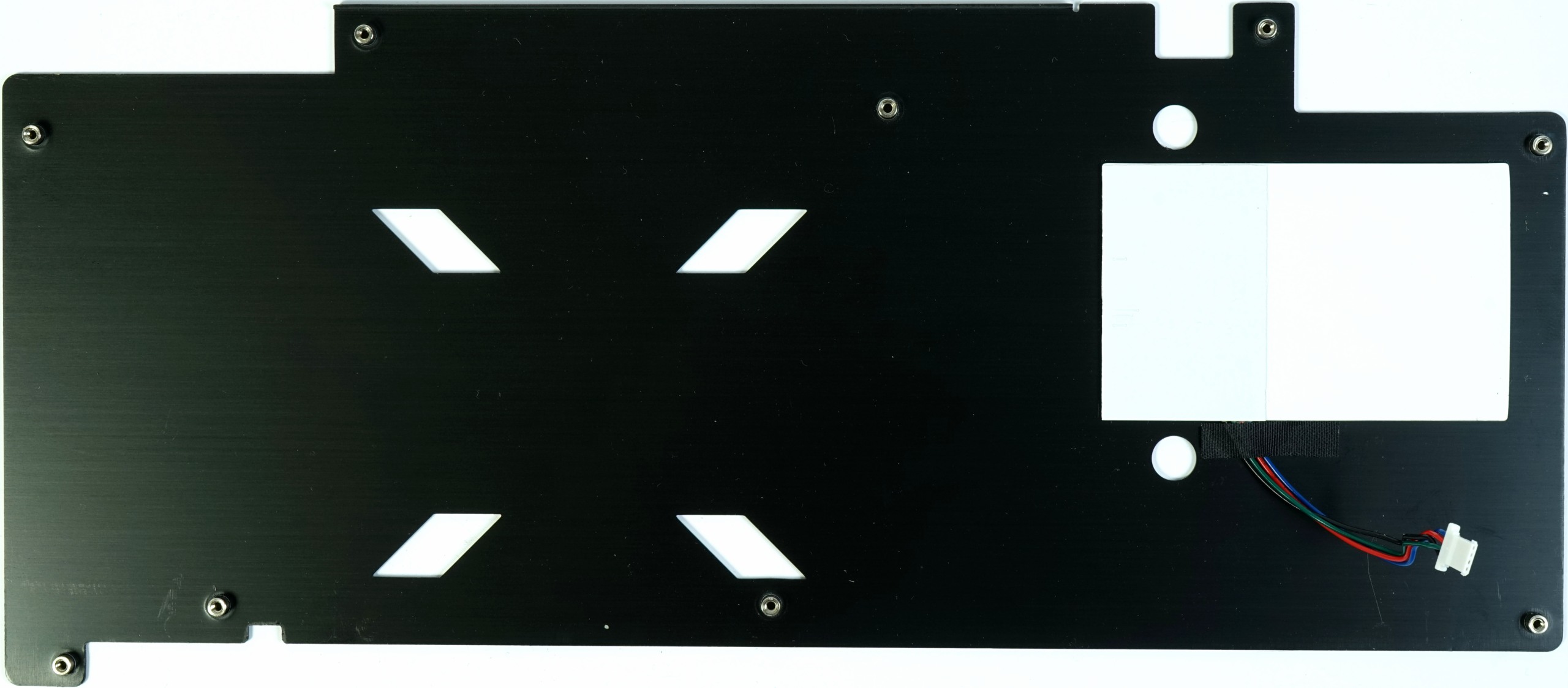
The memory is not cooled via the heat sink, but via a small frame below the actual cooler, which only partially covers the modules. Whether this really works will have to be shown later in our measurement. At least the modules below the fans are directly in the airflow.
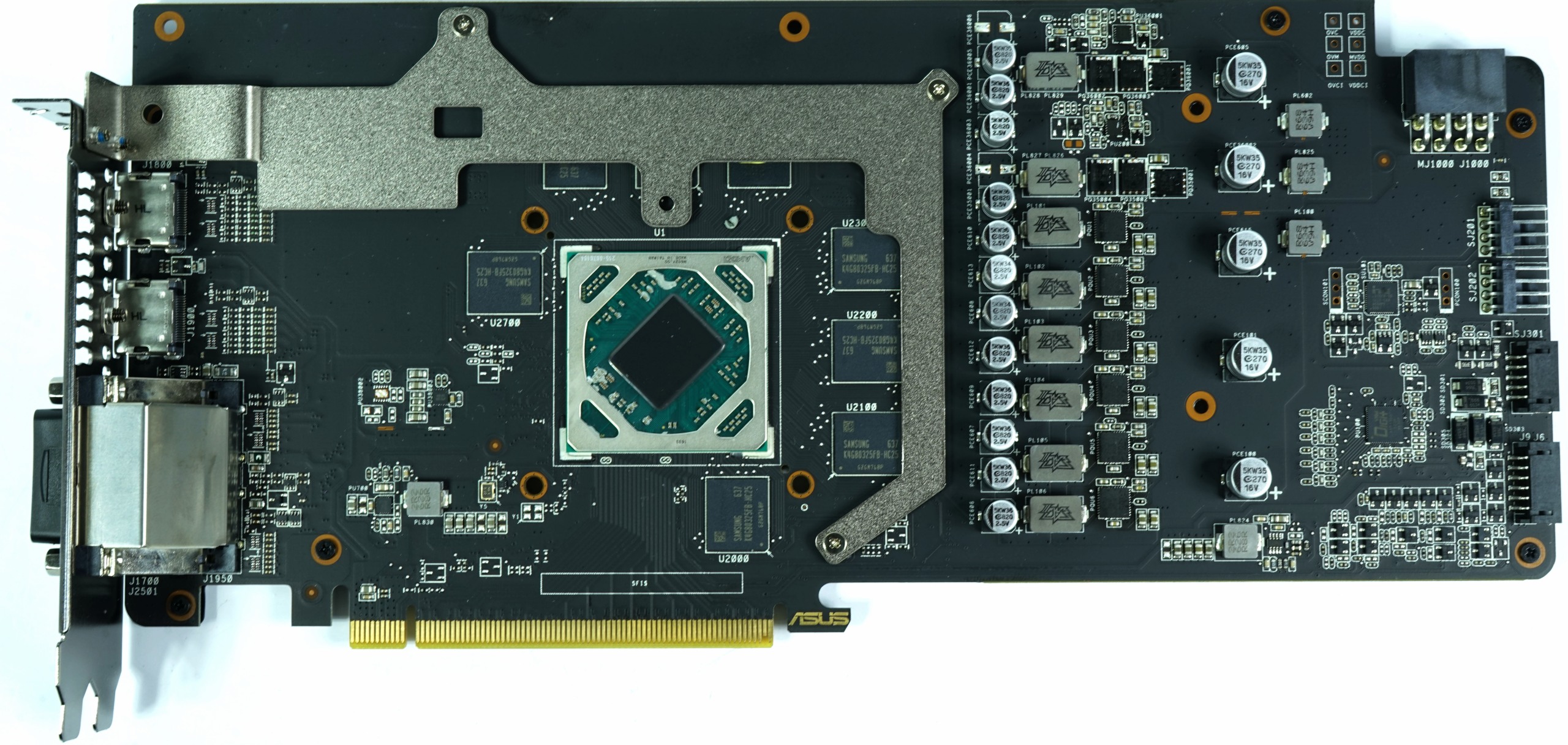
The cooler itself consists of two parts. The larger part sits above an aluminium block that holds together the four nickel-plated 8 mm heatpipes sanded in the GPU range, as well as the 6 mm hetapipe. DHT (Direct Heat-Touch) can go well, but does not have to. We find the heat sink directly integrated in the cooler for the voltage converters good. However, Asus could have been even more consistent by using a graduated solution that also cools the coils.
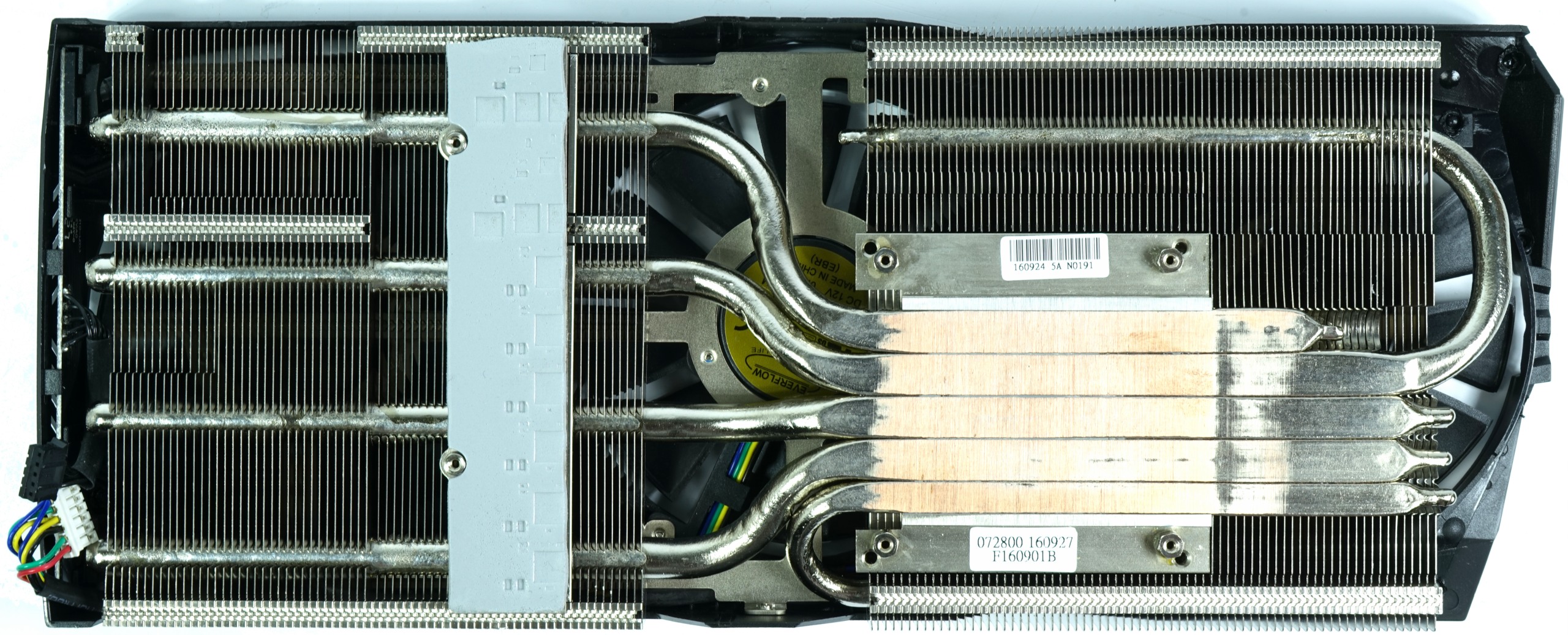
However, the cooling performance is excellent and it is once again true that ambitious motorists are truising that nothing goes beyond displacement (cooler surface) but even more displacement. With a maximum of 65°Cm in closed or 64°C in open construction, the GPU stays cool, whether it's a gaming loop or a stress test. However, the clock decreases something that is solely due to the power limit and not to the GPU temperature.
With an average of 1280 MHz, the card does not make a bad figure, because other cards need for only 50 Mhz more also up to 50 watts more supplied power, which makes the possible gain by the use of the electric crowbar look even more silly leaves.
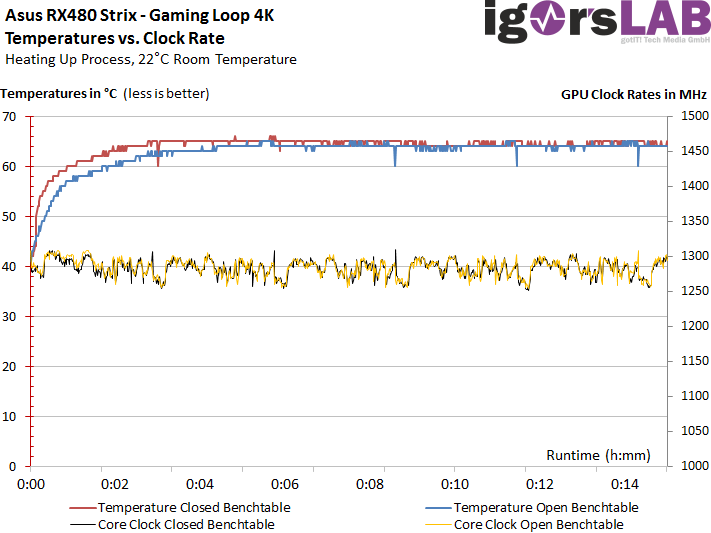 |
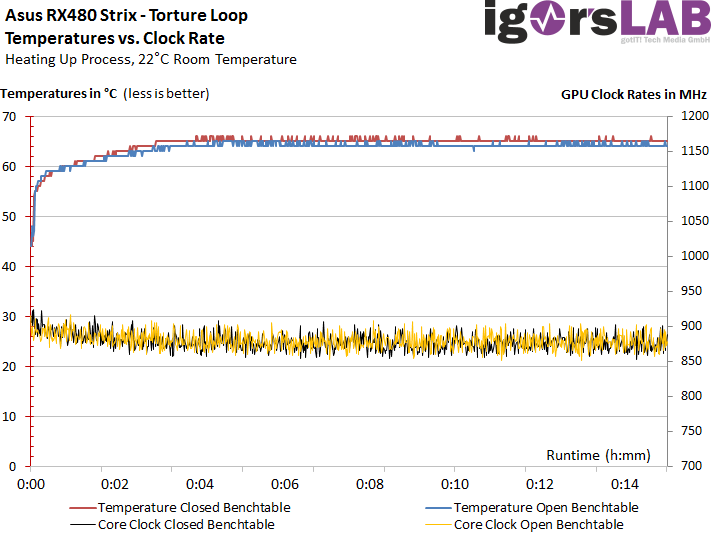 |
Let us now consider the temperatures not as a curve, but check what consequences the load leaves on the board. The memory, we remember, is unfortunately treated a little bit in the cooler by Asus. If the open benchtable is still close to 80°C, we measure just under 83°C in the closed case. This is within the specifications, but could certainly have been even better due to a larger frame. The voltage transformer temperatures of a maximum of 84°C in the closed housing, on the other hand, are in the deep green range.
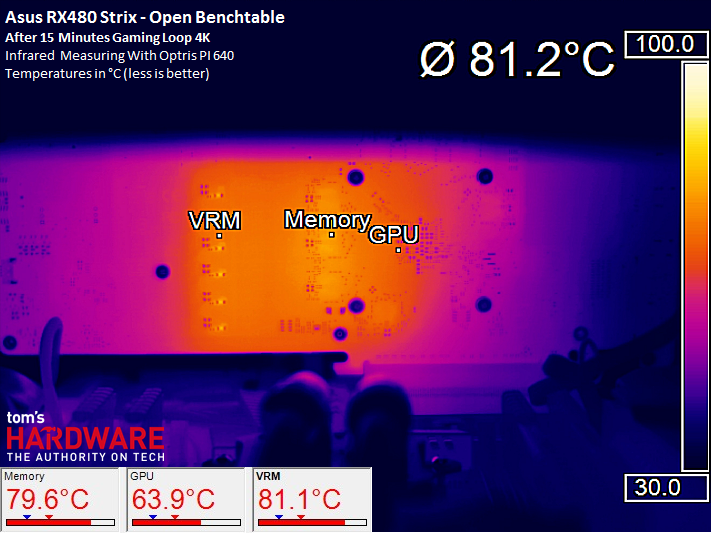 |
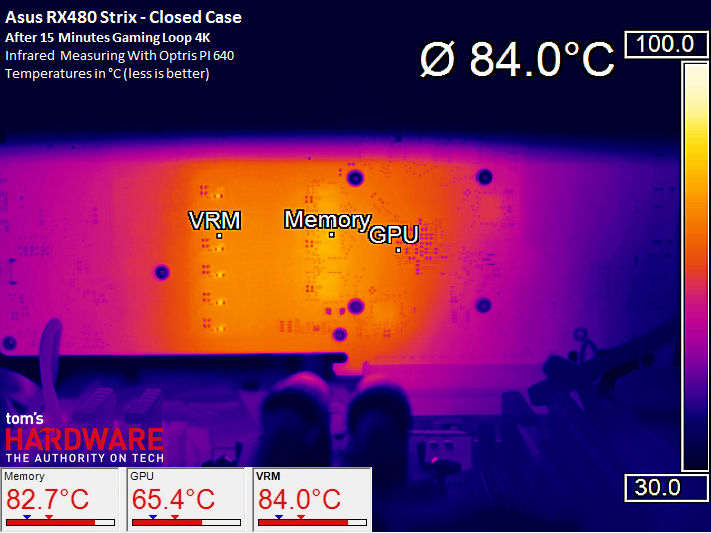 |
A maximum of 84°C of the hottest memory modules in the closed housing in the stress test will scratch at the upper limit of what is acceptable, but no damage should occur, as we are really more likely to provoke the worst case.
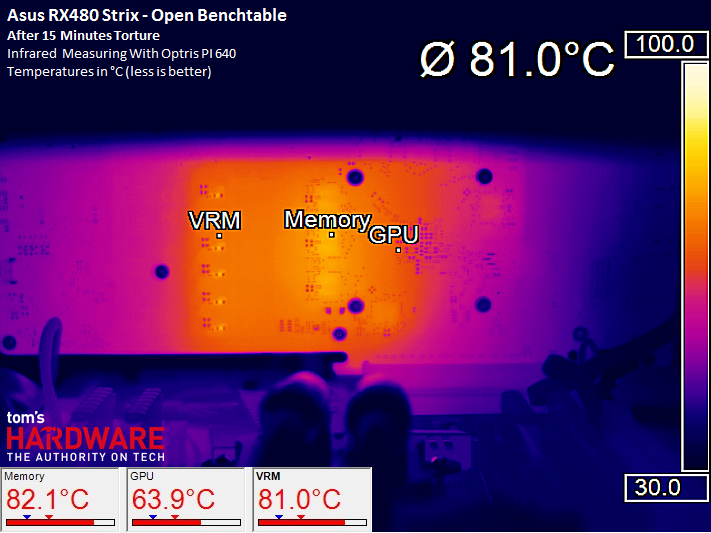 |
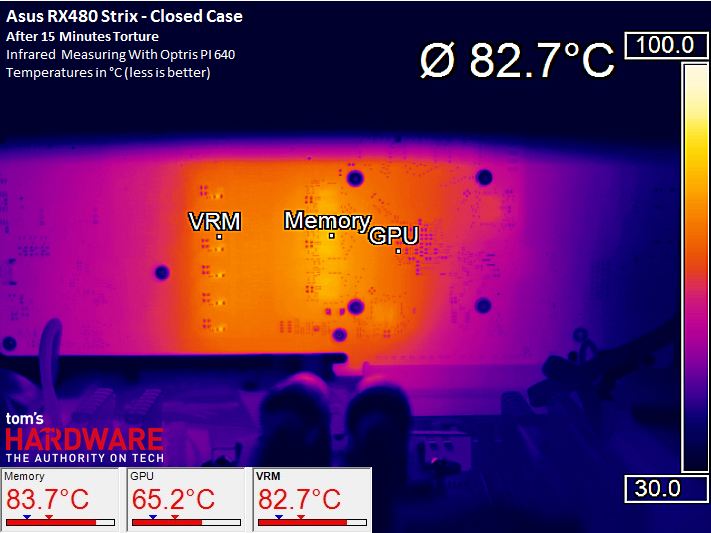 |
The cooling with the DirectCU III shows that it is generally possible to ensure almost equal temperatures of all components in both open and closed construction. We should remember this as a default when comparing the results with those of other maps, which in the closed structure tend to a nervous snap.
5. Fan speeds and noise emission
But where is the reason for the almost identical temperature of the card in the gaming loop in the open trailer or in the closed housing? If we look at the fan speeds, we do not experience any surprise, because the speeds increase by 500 to 600 rpm. This could be considered questionable now, but the installed fan modules are precisely designed for this task.
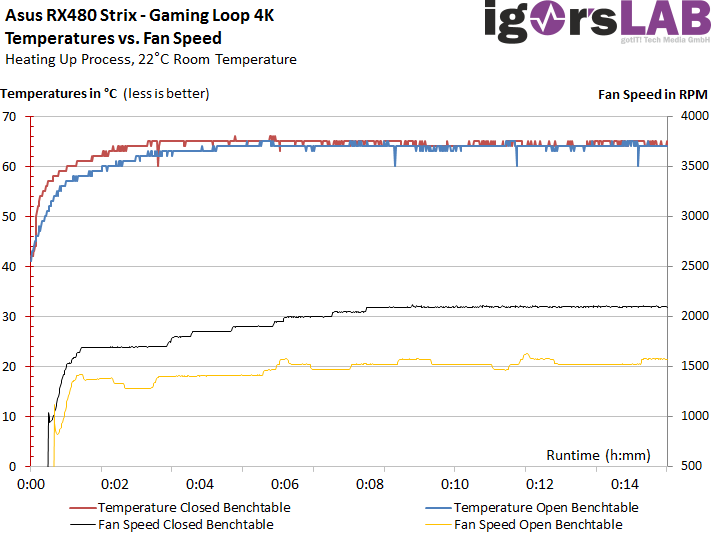 |
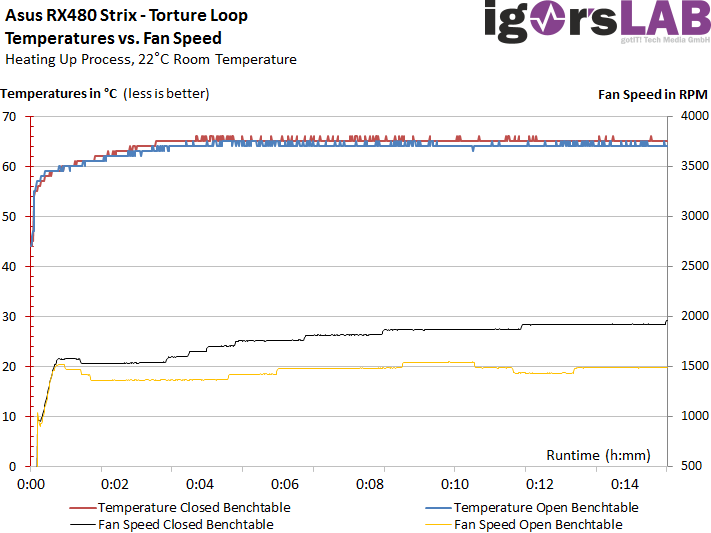 |
Excellent 37.8 dB(A) under full load in the gaming loop set the bar extremely high, especially since the card remains much quieter in the open structure. The resulting noise is broadband and almost free of low-frequency peaks, which can be caused by poor fan bearings. The frequency portion of the voltage transformer noises is also not dominantly represented at the level, but this assembly is subdued in the acoustic overall work of art.
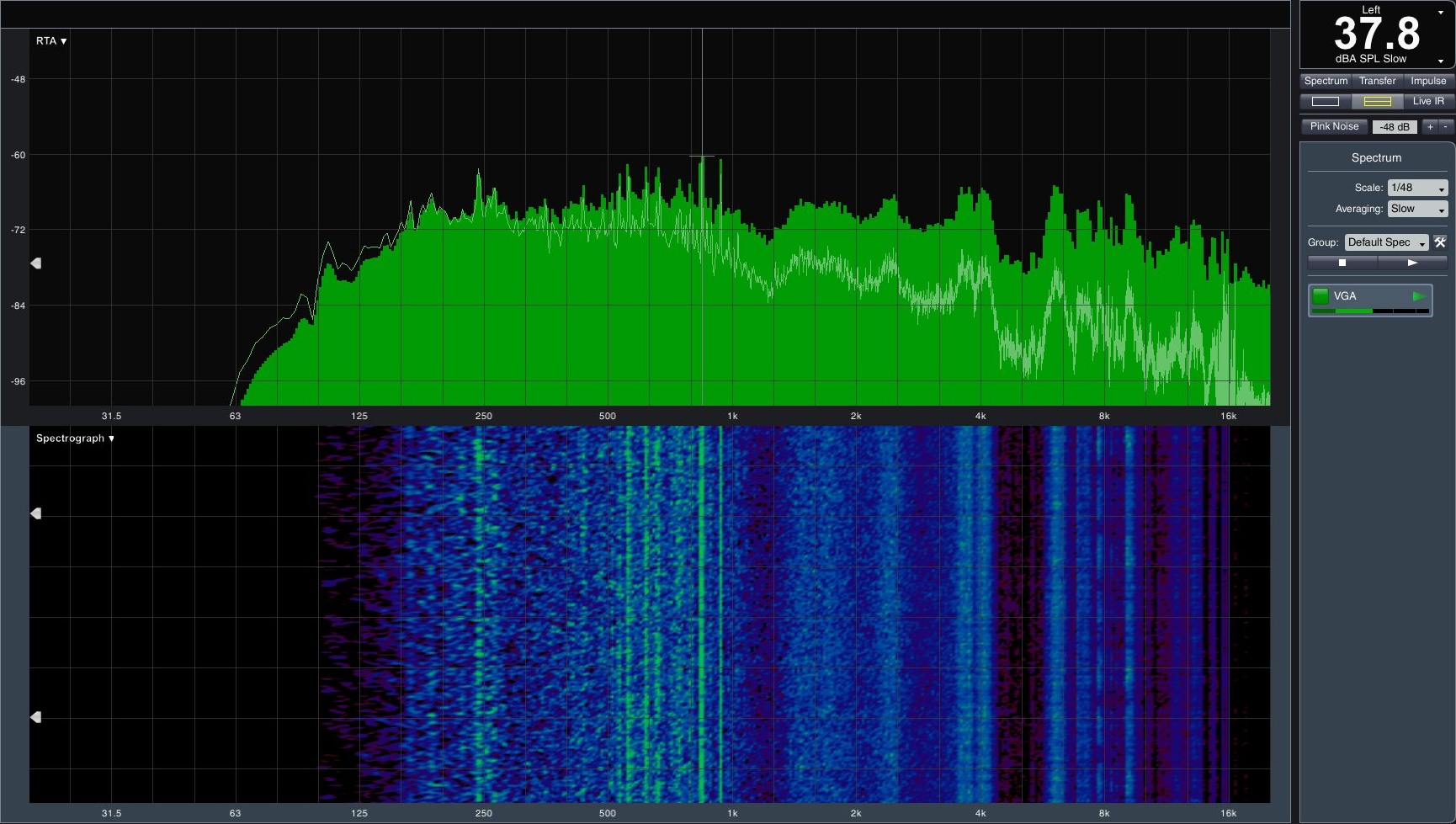
6. Intermediate conclusion
Less is usually more and so Asus presents a card by refraining from hunting for last megahertz at the factory clock, whose extremely good cooling also acts appealingly quietly. Whether open or closed, the values are simply right. It is interesting to see that the card then remains comparatively restrained in terms of power consumption in direct comparison to the partially badly overfed competitor cards and loses a maximum of one to two FPS in practical use. You don't even notice that, but you can measure it to the maximum.
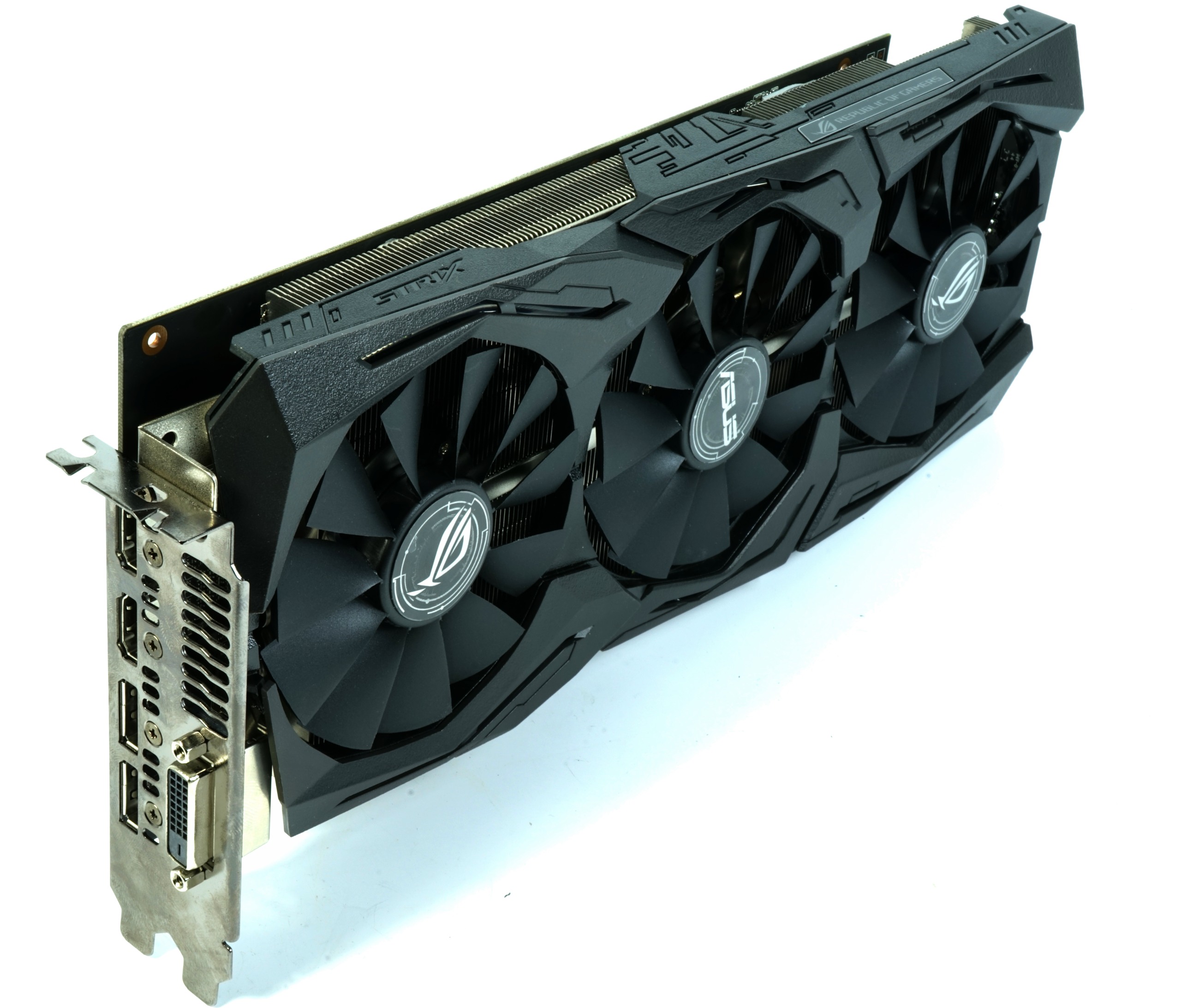
But what you can really hear (or not), is the very discreet work of the fans, who certainly do their service with pleasure on this card. Maximum the sheer length could probably prevent some customers from buying this card as long as they have no problem with the price. If you want a Radeon RX480 sin, then you should always have the Asus card on your plan.
In the end, it was also the only card in this chip series from AMD that, from the tester's point of view, deserves the "Editor's Choce Award" in terms of the really successful balancing act between efficiency (as far as this is possible here), gaming performance and cooling performance. Had. There are faster cards in the test field, but none that would have been implemented in such a sensible way.
- 1 - Einführung, Übersicht und Test-Setup
- 2 - AMD Radeon RX480 Reference
- 3 - Asus RX480 Strix
- 4 - HIS RX480 IceQ X² Roaring Turbo
- 5 - MSI RX480 Gaming X 8G
- 6 - Powercolor RX480 Red Devil
- 7 - Sapphire RX480 Nitro+
- 8 - XFX RX480 GTR Black Edition
- 9 - Übersicht: Gaming-Performance
- 10 - Übersicht: Temperatur, Lautstärke und Leistungsaufnahme
- 11 - Zusammenfassung und Fazit

































Kommentieren